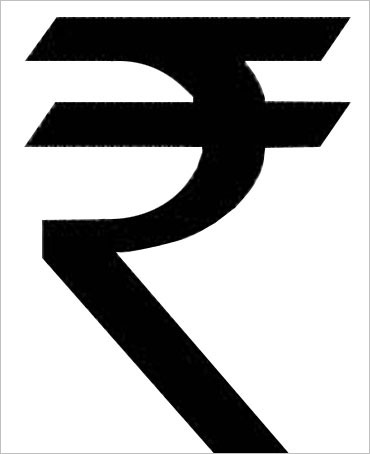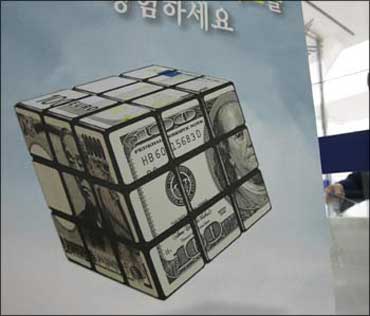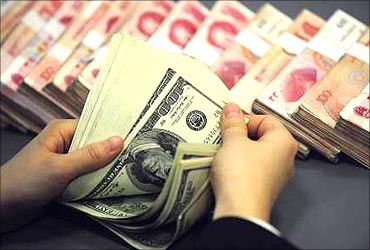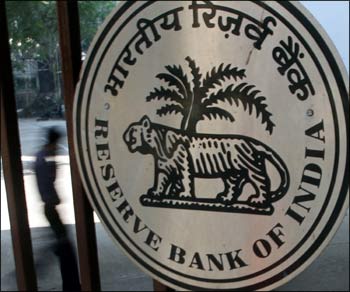 | « Back to article | Print this article |
Why the rupee could depreciate by 20% in 2 years
The Indian Rupee may depreciate by around 20 per cent during next two years on account of dip in confidence about the domestic economy leading to outflow of funds.
According to a report by financial and business research firm Evalueserve, there will be pressure on the Rupee unless steps are taken to fix certain structural issues like high current account deficit and dwindling investments.
"During the next two years the probability of the INR (Indian Rupee) to depreciate is the highest (about 50 per cent) as compared to an appreciation or a status quo scenario," Evalueserve said, adding that the depreciation could be in the range of around 20 per cent.
During the past 12 months, the Indian rupee has traded in a relatively narrow range between 47.33 and 43.99 to the US dollar.
Click NEXT to read on . . .
Why the rupee could depreciate by 20% in 2 years
"However, the pressure on its stability seems to become more evident," it said.
Evalueserve said Indian rupee's depreciation could be fuelled by exit of foreign institutional investor (FII) money and lack of investor confidence on account of governance issues, besides high current account deficit (which is the net flow of income out of the country, barring capital movements).
"Even a relatively orderly outflow of $15 billion of FII money over a year could result in the Indian rupee depreciating by 22-30 per cent. This could imply an exchange rate in the range of Rs 55-60 to every US dollar," it said.
Click NEXT to read on . . .
Why the rupee could depreciate by 20% in 2 years
The situation could be even worse in case the outflow in more faster.
Foreign funds have pulled out nearly Rs 3,400 crore (Rs 34 billion) from the Indian stock market during the first half of May as interest rate pressures continue to mount.
"This risk (outflow) is also heightened by the fact that India's capital markets are very shallow and do not have the capacity to absorb even moderate external shocks," it said.
Click NEXT to read on . . .
Why the rupee could depreciate by 20% in 2 years
Evalueserve pointed to structural factors like the high inflation, which has been blamed on supply side challenges, problems of governance as shown by recent scams, and high deficits.
"Inflation is at an all-time high... The monetary policy changes undertaken by the government to control inflation have been ineffective," the report said, attributing inflation to supply side challenges including lack of infrastructure.
It said that India is the only BRIC economy where foreign direct investment has shown a fall. FDI fell to $19.4 billion in 2010-11 from $25.8 billion in 2009-10.
Click NEXT to read on . . .
Why the rupee could depreciate by 20% in 2 years
"This is troubling as FDI is an important indicator of investors' faith in a country's long-term prospects. foreign institutional investment has been buoyant, but these funds are volatile by nature and are prone to 'flight risk' at the first signs of trouble, something that happened during the financial crisis," Evalueserve said.
It also blamed the recent scams -- as highlighted by the 2G spectrum and CWG cases -- for creating a perception of a 'governance deficit' in India.
"This, combined with regulatory and tax uncertainty, will deter many foreign investors," the report said.
Click NEXT to read on . . .
Why the rupee could depreciate by 20% in 2 years
While the government has not been able to liberalise sectors like insurance for foreign players, the Goods and Services Tax (GST) had to be postponed due to lack of consensus among political parties.
Evalueserve also said the ongoing political crisis in part of Middle East and North Africa can seriously hurt remittances. The MENA region contributes to a substantial chunk of $55-billion remittance received annually from Indians residing abroad.
Regarding deficits, it said: "The government finances are in a bad shape and the combined central and state government deficit has stubbornly stayed around 10 per cent of GDP."
Click NEXT to read on . . .
Why the rupee could depreciate by 20% in 2 years
The RBI had earlier this month said it expects India's current account deficit to be around 2.5 per cent of GDP in 2010-11.
The report said that while such a rate is normal for growing economies, in India's case it bodes ill due to lack of government savings.
"Moreover, given India's rising import bill and threat to remittances, the deficit will remain high in the near future, creating pressure on the Indian rupee," it said.






